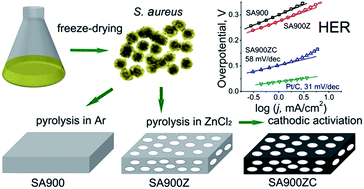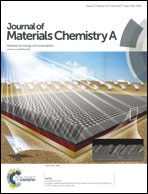A high-performance metal-free hydrogen-evolution reaction electrocatalyst from bacterium derived carbon†
Abstract
We report a sustainable approach to obtain carbon materials with nitrogen and phosphorus dual functionalities from a common bacterium strain (S. aureus) as a highly efficient hydrogen-evolution reaction (HER) catalyst. With mesoporous structure introduced by ZnCl2 salt and cathodic activation, it demonstrates an onset overpotential as low as 76 mV, a Tafel slope of 58.4 mV dec−1 and a large normalized exchange current density of 1.72 × 10−2 mA cm−2, which are comparable to those of hitherto best metal-free and well-fabricated metallic HER catalysts.

- This article is part of the themed collection: 2015 Journal of Materials Chemistry A Hot Papers


 Please wait while we load your content...
Please wait while we load your content...